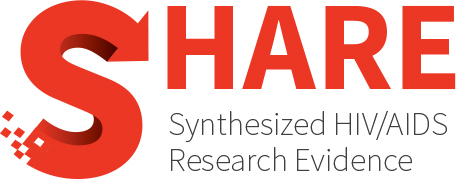Category Archives: Prevention, Engagement and Care Cascade
Systematic review: Safety of surgical male circumcision in context of HIV prevention public health programmes
Background: Since the recommendation of voluntary medical male circumcision (VMMC) to reduce the risk of heterosexually acquired HIV, a number of adolescent boys and men in 15 priority countries in...
Humoral immune response to two doses of COVID-19 mRNA-based vaccines in people living with HIV: A systematic review and meta-analysis
People living with HIV (PLWH) are susceptible to severe COVID-19 infection and hence this fragile population has prioritised vaccination. This systematic review and meta-analysis aimed to assess the humoral immune...
Immunogenicity, effectiveness and safety of SARS-CoV-2 vaccination in people living with HIV: A systematic review and meta-analysis
Objectives: People living with HIV (PLWH) experience a greater risk of morbidity and mortality following COVID-19 infection, and poorer immunological responses to several vaccines. We explored existing evidence regarding the immunogenicity,...
Intergenerational spillover effects of antiretroviral therapy in sub-Saharan Africa: A scoping review and future directions for research
BACKGROUND: Antiretroviral therapy (ART) may influence individuals who do not receive the intervention but who are connected in some way to the person who does. Relatively little is known, however,...
“What’s sex and gender got to do with it?” A scoping review of sex and gender-based analysis in pharmacoepidemiologic studies of medication adherence
BACKGROUND: Medication taking is a complex multidimensional behaviour that may be impeded by a range of biological and psychosocial factors, including sex and gender. We aimed to synthesize how sex...
Disparities in healthcare access and utilization among people living with HIV in China: A scoping review and meta-analysis
Background Healthcare disparities hinder the goal of ending the HIV pandemic by 2030. This review aimed to understand the status of healthcare disparities among people living with HIV (PLWH) in...
The recent natural history of human papillomavirus cervical infection in women living with HIV: A scoping review of meta-analyses and systematic reviews and the construction of a hypothetical model
Background: Women with HIV are more often infected with human papillomavirus (HPV) and are more prone to develop precancerous cervical lesions (squamous intraepithelial lesions, SIL) and invasive cervical cancer (ICC) than...
Evidence gaps on weight gain in people living with HIV: A scoping review to define a research agenda
BACKGROUND: Combined antiretroviral therapy (cART) dramatically improved survival in people living with HIV (PLWH) but is associated with weight gain (WG), raising concern for a possible obesity epidemic in PLWH....
Incidence of Pneumocystis pneumonia in immunocompromised patients without human immunodeficiency virus on intravenous pentamidine prophylaxis: A systematic review and meta-analysis
BACKGROUND: Trimethoprim-sulfamethoxazole (TMP-SMX) is a first-line Pneumocystis pneumonia (PCP) prophylaxis agent, but monthly intravenous pentamidine (IVP) is used in immunocompromised hosts without human immunodeficiency virus (HIV) infection because IVP is...
The innovative use of qualitative and mixed methods research to advance improvements along the HIV prevention and care continua
PURPOSE OF REVIEW: Despite enormous advances in prevention and care modalities, HIV continues to burden populations around the globe and is largely driven by social and behavioral processes. Mixed methods...
What factors are associated with willingness to use HIV pre-exposure prophylaxis (PrEP) among U.S. men who have sex with nen not on PrEP? A systematic review and meta-analysis
Pre-exposure prophylaxis (PrEP), an antiretroviral medication to prevent HIV, is becoming more widely available in the United States since the Federal Drug Administration approved it in 2012. However, PrEP use...
